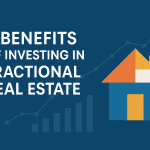Introduction: The Truth About Fractional Real Estate
When people first hear about fractional real estate investing, they either think it’s too good to be true… or they think it’s a scam. The truth? It’s neither. Fractional real estate is changing how everyday folks — people like you and me — can own income-producing property without the headaches of being a landlord.
I’ve been in real estate for years. I own commercial property right here in Tennessee, but I also put my money into fractional platforms like Fundrise, Ark7, Groundfloor and RealBricks. And I’ll be the first to tell you — there are some shocking truths most people don’t know about this space.
Today, I’m laying out 10 shocking truths about fractional real estate that no one tells you. By the end, you’ll know exactly what’s real, what’s risky, and what’s worth your time.
👉 Stick around until the end, because I’ll share the smartest way to get started (without making the mistakes that wipe out so many beginners).
1. You Don’t Need to Be Rich to Get Started
Traditional real estate requires a down payment, good credit, and a hefty bank account. With fractional real estate, you can start with as little as $10–$100. That’s a game-changer.
Platforms pool your money with other investors, letting you buy a fraction of a property. It’s like crowdfunding, but for real estate that actually pays you back.
💡 Shocking Truth: You can be a property owner without ever mowing a yard, fixing a leaky faucet, or taking out a mortgage.
2. Fractional Real Estate Isn’t the Same as REITs
A lot of people confuse fractional investing with REITs (Real Estate Investment Trusts). Both give you exposure to real estate, but here’s the difference:
- REITs trade like stocks and often own large portfolios of commercial properties.
- Fractional platforms let you own shares in specific properties — like a rental house in Dallas or a duplex in Atlanta.
That means you can hand-pick where your money goes, instead of being tied to a big corporate fund.
💡 Shocking Truth: Fractional real estate gives you more control than a REIT — you choose the property, not just the ticker symbol.
3. The Returns Can Beat the Stock Market
Long-term, the stock market averages about 7–8% annually. Some fractional real estate deals offer 10–15% returns when you factor in rental income plus appreciation.
Of course, nothing is guaranteed — but if you diversify and reinvest your payouts, you can outpace traditional investments.
💡 Shocking Truth: Many investors don’t realize fractional real estate can grow faster than their 401(k).
4. Liquidity Is Still a Challenge
Here’s the part the glossy marketing leaves out: fractional real estate isn’t always liquid. If you need your money tomorrow, you can’t just hit “sell” like you do with stocks.
Some platforms offer secondary markets or redemption windows, but it’s not instant. That means you need to invest money you can leave in the deal for at least 3–5 years.
💡 Shocking Truth: Your money can get locked up longer than you expect.
5. Diversification Is Easier Than Ever
In traditional real estate, most people can only afford one property at a time. With fractional investing, you can own tiny slices of dozens of properties across different states.
That spreads out your risk and protects you from being sunk by a single bad tenant or local downturn.
💡 Shocking Truth: For the first time in history, everyday investors can build nationwide real estate portfolios without being millionaires.
6. The Tax Benefits Are Real — If You Know Where to Look
One of the best-kept secrets about fractional real estate is the tax angle. Some platforms pass along depreciation benefits and write-offs, reducing your taxable income. Others don’t.
That’s why you’ve got to read the fine print. And yes — even small investors may be eligible for perks.
💡 Shocking Truth: Fractional real estate can lower your tax bill if you pick the right platform.
7. Some Platforms Are Much Safer Than Others
Not all fractional platforms are created equal. Some are highly regulated by the SEC with clear legal structures. Others… well, they’re startups that may or may not last.
That’s why I always recommend sticking with trusted platforms that have proven track records.
💡 Shocking Truth: Choosing the wrong platform is the fastest way to lose money.
8. Passive Doesn’t Mean Risk-Free
Yes, fractional investing is passive income — no tenants calling at 2 AM. But don’t mistake passive for risk-free.
- Property values can drop.
- Platforms can fail.
- Rental markets can shift.
You’ve got to treat this like any investment — do your research and never put in more than you can afford to lose.
💡 Shocking Truth: “Hands-off” doesn’t mean “set-it-and-forget-it.”
9. Compounding Is the Real Wealth Builder
The smartest fractional investors don’t cash out their payouts. They reinvest. That’s how $100/month can turn into tens of thousands over time.
It’s not the flashy flips that make people rich — it’s the boring consistency of compounding returns.
💡 Shocking Truth: Reinvesting your rental payouts is how fractional investors quietly build fortunes.
10. Fractional Real Estate Is Here to Stay
Some people think fractional real estate is just a fad. But look around — technology has changed everything: ridesharing, streaming, online banking. Real estate is next.
Institutional investors are already moving billions into this space. That’s a clear signal: fractional real estate isn’t going anywhere.
💡 Shocking Truth: We’re still early — and that means there’s opportunity for those who get in now.
Who Should Consider Fractional Real Estate?
Fractional real estate isn’t for everyone. It’s ideal if you:
- Want passive income without being a landlord.
- Have a long-term mindset (3–5+ years).
- Like the idea of diversifying across multiple properties.
- Can start small but want to scale with consistency.
It’s not ideal if you:
- Need quick liquidity.
- Refuse to accept risk.
- Won’t take time to research platforms.
Getting Started (The Smart Way)
Here’s how I’d recommend beginners dip their toes into fractional real estate:
- Pick one platform to start with — Fundrise, Ark7, or Groundfloor are solid options.
- Start small — $100–$500 is enough to get your feet wet.
- Diversify early — spread your money across 3–5 properties.
- Reinvest payouts — let compounding do its work.
- Stay patient — give it at least 3–5 years before judging results.
FAQs About Fractional Real Estate
Q: Is fractional real estate safe?
A: Safer than trying to manage a rental on your own, but not risk-free. Stick with regulated platforms.
Q: Can I lose money?
A: Yes, like any investment. But diversification helps reduce the risk.
Q: How do I pay taxes on fractional income?
A: You’ll usually get a 1099 form from the platform. Always talk with a tax professional.
Q: What’s the minimum investment?
A: Some platforms let you start with as little as $10. Others require $100–$500.
Conclusion: Don’t Wait on the Sidelines
Fractional real estate isn’t hype — it’s real. And it’s opening doors for everyday people to build passive income and long-term wealth.
The shocking truths I’ve shared aren’t here to scare you — they’re here to prepare you. If you know what to expect, you can invest smarter and grow faster.
👉 Want to see where I’m investing? Check out these platforms I personally use:
✅ Affiliate Disclaimer (Win-Win Style): Some of the links above are affiliate links. That means I may earn a small commission if you decide to invest — at no extra cost to you. It’s a win-win: you get access to solid platforms, and I keep this blog running to share free resources like this.
✅ Disclaimer: I am not a licensed financial advisor, attorney, or tax professional. The information I share is for educational and informational purposes only and should not be taken as financial, investment, or legal advice. You should always conduct your own research and consult with a qualified professional before making any financial decisions.


